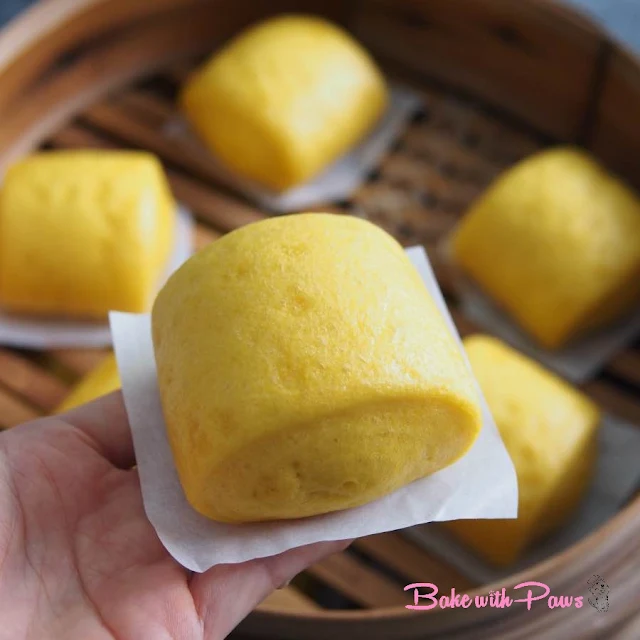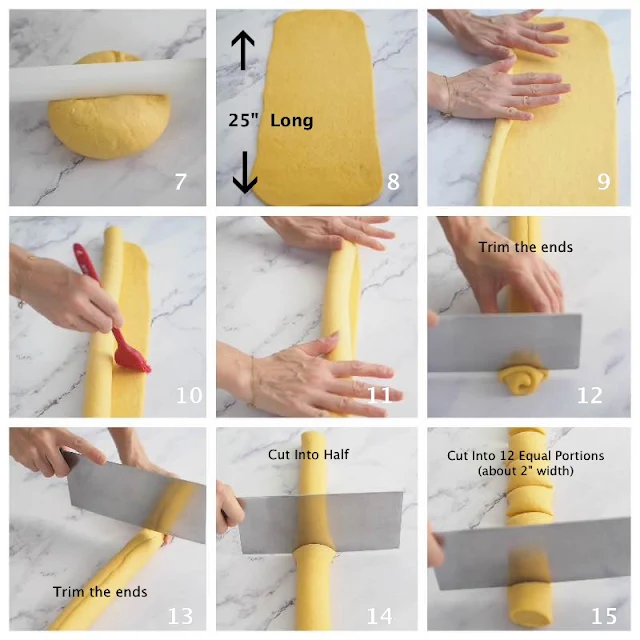MISC RECIPES - Steamed Buns (Mantou/Pau)
PUMPKIN MANTOU (STEAMED BUN)
July 18, 2017
| Recipe by Bake with Paws
In my personal opinion, I found that making soft and delicious steamed buns (Mantou) is not difficult. However, achieving a smooth skin is a challenge for me. I have made several attempts to try to get as smooth a skin as possible. The result is not perfect yet.
For other Steamed Buns, please click here for the recipes.
How To Get Smooth Steamed Buns:
- Low hydration dough around 51% - 55% (depend on the type of flours used). High hydration and wet dough may make the buns wrinkle.
- Try not to proof the buns too long. Over proofing will cause the buns collapse when steaming and get wrinkle.
- Cover the lid of the steamer with a kitchen towel. This will prevent steamer water dropping on the bun, to get a smooth skin.
- Steam the buns at medium or medium low heat. High heat will cause the buns rise very fast and collapse, and the buns will not come out with smooth top.
- Sudden temperature change will cause the buns shrink and get wrinkle. It is always advisable not to open the lid immediately after steaming. Once it’s done transfer the bamboo steamer away from the hot water and let it stand for another 5 minutes before removing the cover.
If you have any questions regarding this recipe or any other post, please leave me a comment in the “LEAVE A COMMENT” link and I will reply you as soon as possible. Do tag me on Instagram @Bakewithpaws if you attempt on this recipe.
Recipe - Pumpkin Mantou (Pumpkin Steamed Bun)
Yields: 12 Mantou
INGREDIENTS:
300 plain flour or pau flour (I used Bakers' Choice Pau Flour)
145g mashed pumpkin (about 250g pumpkin - peeled, cut, steamed and mashed)
20g castor sugar (I used light brown sugar)
1 tsp (3g) instant yeast
1 tbsp or 15 ml olive oil or 15g butter (room temperature)
50g water
12 pieces (3” X 3") baking parchment paper
METHOD:
- Mashed Pumpkin:
- Wash, peel, cut and steam the pumpkin for about 20 minutes. Mash with potato riser or you can blend with electric hand blender.
- Mixing and Kneading Dough:
- Combine water and yeast in a bowl of electric stand mixer. Then add in the rest of the ingredients. Mix with the paddle attachment until all come together, smooth and soft around 5 - 8 minutes. The dough should be quite dry. You can use hook attachment too. But, I find paddle attachment works better for me.
- 1st Proofing:
- Shape into a ball. Put in back in the same mixing bowl, cover and let the dough rest for 15 minutes.
- Shaping:
- Lightly dust the working surface with flour. Roll out the dough to a rectangle about 25" long.
- Roll the dough tightly from the longer edge to form a log. Brush with a thin layer of water to seal the edge.
- Trim both ends and cut the remaining dough into 12 equal portions (about 2" width).
- Place each mantou on a piece of prepared parchment paper.
- Spread the mantous on the bamboo steamer about 1 inch apart as the dough will rise.
- 2nd Proofing:
- Let the buns rise until 50% from its original size about 30 - 40 minutes in warm area. Please read the general notes below.
- Steaming:-
- Prepare the steamer. Cover the top with a kitchen towel. This will prevent steamer water dropping on the bun, to get a smooth skin. Steam for 15 minutes over the low medium heat.
- Once it’s done transfer the bamboo steamer away from the water and let it stand for another 5 minutes before removing the cover. With this, the buns will not shrink after cooling down.
NOTE:
PROOFING
Please note that the proofing timing may also vary depending on your climate and environment. The humidity and temperature at your place will influence how dough rises.
How do I know my buns have risen enough?
1. You should feel lighter when you lift the buns up.
2. The buns should increase about 50% than their original size.
3. If you are unable to judge by just looking at the dough, you can do the finger poke test:
- Lightly press the side of the proved dough with your finger. If it bounces back immediately without any indentation, it means the dough is under proved and needs more time before baking.
- If the indentation stays and it doesn’t bounce back, it means it has been over proved.
- If the indentation slowly bounces back and leave a small indentation, it is ready to bake.
- There will be a final burst of rising once the bread is placed to bake in the oven and it is called oven spring.






Comments
Post a Comment